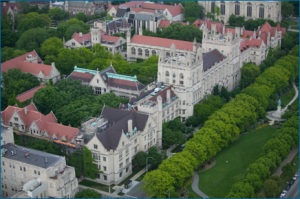Update: The University selected Diller Scofidio + Renfro. This firm has been involved in many high-profile projects recently, including the MoMA, the High Line, the Broad Museum in Los Angeles, and major new buildings for Columbia and Stanford. The building will be the firm’s first in Chicago.
A new building south of the Midway, on 60th Street and S. Woodlawn Avenue, is planned for completion in 2018 on the empty site (brick walkups used for faculty housing were demolished in 2013). Across Woodlawn it faces the current Harris School building and it shares the block with the Modernist Charles Stewart Mott Building, an office building.
It will be called the Rubenstein Forum after billionaire donor David M. Rubenstein, of The Carlyle Group fame. The University’s news release from October announcing the donation was vague about what purpose the building will serve: supposedly it will be “an innovative facility designed to foster convening and collaboration and to serve as a physical hub for a broad array of University activities,” such as academic conferences. To me it is not quite clear why this building is “much needed,” as President Zimmer says. However, who can complain if a benefactor wants to give an unspecified but doubtless hefty sum for a new building?
This building, moreover, presents a perfect opportunity to expand Neo-Gothic architecture south of the Midway. Only one building, a dormitory, was built by the University south of the Midway in the period when the University was still fully committed to the Gothic style: Burton-Judson Courts aka BJ (Zantzinger, Borie & Medary, 1931). Another building, Chapin Hall (known as the Merriam Center until the 1980s), was built in 1938 by the successor firm Zantzinger & Borie with funding from the Rockefeller Foundation for a number of institutions related to public administration such as the American Planning Association which chose this location to benefit from a proximity to University researchers. (This arrangement was not unique–the American Meat Institute and the ABA whose old headquarters is now the Harris School also chose to locate themselves at the University of Chicago.) Other than these two buildings, there are no classic limestone, red-roofed Neo-Gothic structures on 60th Street to mirror the buildings on the Midway’s north “street wall.” The Press building (Booth Hansen Architects, 2000) is in an updated “postmodern” structure with Gothic features made of limestone. Counting this building, which is on the fringe of campus and in a quite different style, you have only three Neo-Gothic buildings on 60th Street compared to eleven along 59th Street. And the two 1930s buildings are separated by four full city blocks.
My proposal then is for a realistic Neo-Gothic building with the traditional red terra cotta tile roof. At the very least, an updated style of Neo-Gothic limestone building such as that exemplified by the Knapp Medical Research Building / Donnelly Biological Sciences Learning Center (Stubbins Associates, 1994) should be chosen. The major problems are that it is both expensive and passé to do this kind of thing. But there are firms still doing it. The obvious choice would be Thomas H. Beeby’s firm, HBRA Architects, which did exactly the same thing I want done here when they built this addition to the Oriental Institute in 1998. Another option would be David M. Schwarz whose 2001 Yale Class of ’54 Environmental Science Center is also classic Neo-Gothic. My rationale is to to make 60th Street cohere better with the rest of campus. In particular, if you add another strip of red roofing from a distance the eye will “connect” BJ and Chapin Hall with each other and you will get an (interrupted) version of the impression of a unified “facade” (a so-called “street wall”) created by the 59th Street buildings. (Note: If you put red terra cotta tiles on the Press building that might also be nice, but is not necessary.) This picture shows what I mean by “unified facade” and “street wall”:
My general goal is not new. The University has for most of its history tried to link 60th Street architecturally with the 59th Street “facade.” When the campus began to expand south of the Midway, Eero Saarinen’s Laird Bell Law Quadrangle, and even the Mott Building (Schmidt, Garden & Erikson), built in 1960 and 1959 respectively, framed their glassy facades in limestone. This initial impetus for harmony was discarded a few years later by fellow Modernists Mies van der Rohe and Edward Durell Stone, whose respective School of Social Service Administration building and New Graduate Residence Hall paid no attention to the rest of the campus’s architecture. (Fortunately, Mies’s building, though not Stone’s, is so elegant and such an outstanding example of his style that it is a net positive for the campus.) But the Press building brought back the Gothic style. And Renee Granville-Grossman Residential Commons, while modern in style, used limestone and based its shape off of BJ’s. The tower of the limestone Logan Center (Tod William Billie Tsien Architects, 2012) alludes to Rockefeller Chapel and the Harper Library towers.










